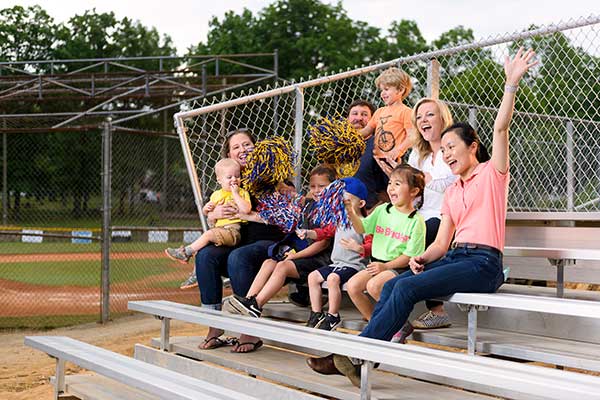 Aluminum bleachers offer versatility in seating capacity and configurations
Aluminum bleachers offer versatility in seating capacity and configurations
One of the great advantages when choosing Aluminum Bleachers is the flexibility this product provides as far as spectator seating in locations with different footprints.
Have some fans for a soccer league, but not a huge amount? Consider 4-row bleachers.
Have a small space but lots of fans? Consider 10-row elevated bleachers.
Have a tight budget but multiple fields to cover? Consider 5-row Portable bleachers.
Have an unusual footprint of land to fill? Experts can design Custom Bleachers to accommodate your specific needs for different dimensions.
Another advantage is that perhaps you determined 4 row bleachers are fine for your field. But you are worried about having enough capacity. Instead of ordering 15-foot long bleachers, considering adding a few feet extra and going to 21 or 27 feet for added capacity.
Aluminum bleachers seating formula
 Sample seating layout for sports bleachers
Sample seating layout for sports bleachers
When ordering aluminum bleachers and trying to determine the size and capacity, here are some handy tips.
Generally, figure the average person takes up 18 inches of space on a bleacher seat. That is the industry standard.
Therefore, for 4-row bleachers, consider these lengths and seating capacity.
- 7.5 feet - 20 seats (90 inches divided by 18 inches equals 5 seats, times 4 rows equals 20 seats).
- 9 feet - 24 seats
- 15 feet - 40 seats
- 21 feet - 56 seats
- 24 feet - 64 seats
- 27 feet - 72 seats
As you can see from above, just adding a few feet can accommodate quite a few more spectators.
However, when you get into more rows or elevated bleachers, the capacity gets a little trickier because you need to accommodate an aisle and railings.
Take 10 row, 27-foot long aluminum bleachers for example.
- Half of the bleachers on one side of an aisle would be 8-foot long planks and seat 5 people per row.
- Times 9 rows would be 45 total seats.
- The other half of the bleachers would be 14 feet in length. Those planks would hold 9 people.
- Times 9 rows would be 81 seats.
- The back row would not need an aisle and would seat 18 people.
- The total number of seats for a 10-row bleacher, 27 feet in length would be 144.
That's still quite a few people seated in a space that is only about 10 yards wide.
Of course, there are other features that can be added to aluminum bleachers.
Consider elevated bleachers. These raised bleachers offer much better "sightlines" of the field. They allow spectators to see over the players and offer a wider view of the event.
Another consideration, especially for large sets of aluminum bleachers, is ADA seating. In this case, cutouts are made in the bottom row to accommodate wheelchairs. It's also important to include companion seating for disabled spectators as well. And if you have elevated bleachers, a ramp must be installed for wheelchair access.
You might want to consider ADA access. Experts say about 20% of Americans have some sort of disability. Plus, with a large portion of the population growing older, you will want to make room for grandma and grandpop to watch the game.
Anodized finish for seating planks
To offer the best experience for spectators, it's recommended to order bleaches with anodized aluminum seat planks.
Anodizing is an electrochemical process where the finish is actually embedded into the metal. Right into the aluminum substrate.
This is achieved by dipping the seat planks in an acid electrolyte bath and then passing a current through the material. Oxygen and aluminum ions intermingle, so the protective covering is literally baked right into the planks.
This way the bright, clean finish on the seats won't peel or flake. (Unlike wooden bleachers). The coating is corrosion resistant. Standing out in the sun all day long under harmful UV rays won't affect the aluminum.
In addition, this durable surface is super easy to maintain. Many times it can be cleaned with just soap and water. Life expectancy is 20 to 30 years.
Generally, for the foot planks, a mill finish is used. That finish is an oxide coating that is natural and acts as a type of protection for the metal. It may discolor a bit initially when first exposed to weather, but eventually, the entire surface will conform to the same look over time.
As you can see, aluminum is an amazing metal. And there's plenty of it. In fact, aluminum is one of the most prevalent elements on Earth.
Another great quality that this metal possesses is that it is recyclable. So the same metal can be used over and over again to build aluminum bleachers.
Make sure you order bleachers that are IBC-Compliant and meet recognized safety standards.
Also, be sure the bleachers come with bolts, nuts and other hardware that is hot-dipped galvanized steel. Again, to prevent rust and corrosion.
Be sure to purchase those aluminum bleachers from a manufacturer with a quality reputation.
For your local fans and spectators, you want to provide a safe and rewarding seating experience.
With aluminum bleachers, you will get a sturdy structure with high seating capacity that is reasonably priced, but is also almost maintenance-free and will stand for a very long time.


